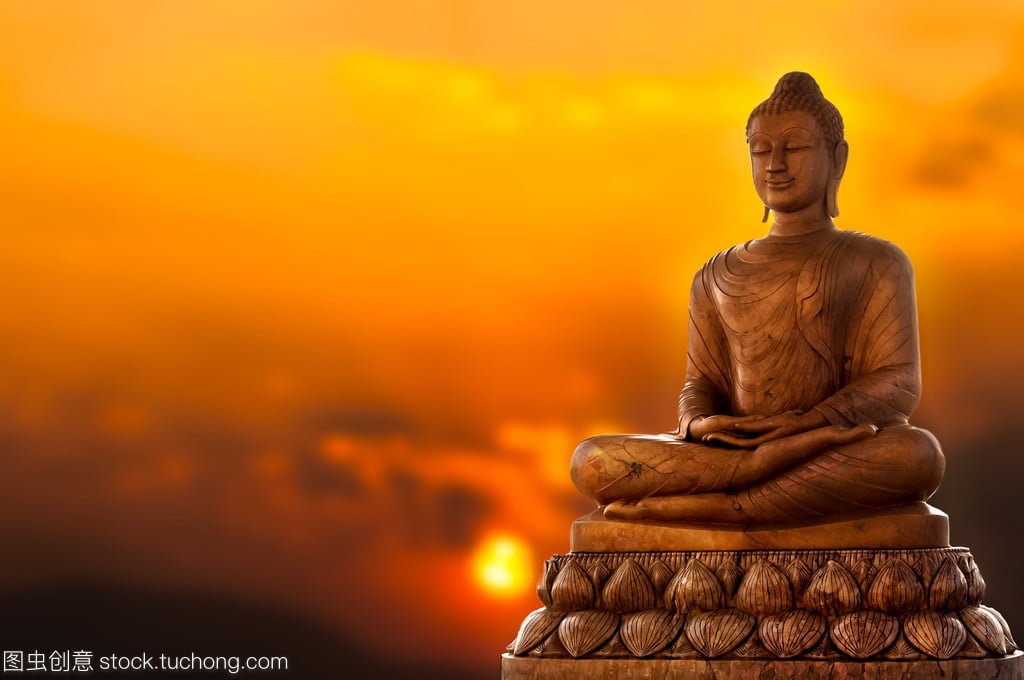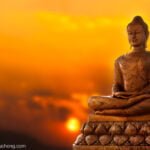Tibetan Buddhist hand gestures, or mudras, (ཕྱག་རྒྱ་) carry deep spiritual meanings and have become increasingly popular in today’s world. These ancient symbols bridge the gap between spiritual practice and modern life, showing a strong connection to Western concepts of mindfulness and science. However, it’s worth noting that Tibetan Buddhism‘s spread in the Western world sometimes faces perceptions of being exclusive.

Understanding the Abhaya Mudra
The Abhaya Mudra is a powerful symbol of protection, peace, and kindness. It’s made by raising the right hand to shoulder level, palm forward, with fingers together and pointing up, while the left hand rests by the side. This gesture is not just about physical safety but also about removing fear from our minds and hearts.
This mudra has roots in ancient traditions, even before Buddhism, symbolizing friendly intentions toward others. It has a rich history in art and storytelling, from the walking Buddha statues in Thailand and Laos to tales of the Buddha calming a wild elephant. This mudra illustrates the Buddha’s teachings’ ability to overcome fear and aggression with calmness and compassion.
The Bhūmisparśa Mudra: The Earth Witness
The Bhūmisparśa Mudra, or “earth witness” mudra, is depicted by the Buddha sitting in meditation, his left hand on his lap, palm up, and his right hand touching the ground. It represents the moment of the Buddha’s enlightenment, calling upon the earth goddess to witness his victory over doubt and distraction. This mudra is a powerful symbol of determination, inner peace, and the achievement of spiritual awakening.
The Bodhyangi Mudra: Insight and Unity
Another significant gesture, the Bodhyangi Mudra, is often associated with the Vairocana Buddha. It symbolizes the unity of all things and the insight into the true nature of reality. By clasping the left forefinger with the right hand, this mudra represents the interconnectedness of the world and the wisdom that comes from understanding this connection.
Discovering the Essence of Buddhist Mudras: Dharmachakra and Dhyāna
In the profound journey of Buddhist practice, mudras (symbolic hand gestures) play a crucial role in conveying spiritual teachings and principles. Among these, the Dharmachakra and Dhyāna mudras stand out for their significance and symbolism, deeply rooted in the Buddha’s teachings and the meditative quest for enlightenment.
Dharmachakra Mudra: The Wheel of Dharma
The Dharmachakra mudra, known as the “turning of the wheel” gesture, commemorates the Buddha’s first sermon at Deer Park in Sarnath, marking the inception of his teachings spreading across the world. This gesture, which symbolizes the setting into motion of the Wheel of Dharma, is primarily associated with Gautama Buddha and, in some traditions, with Maitreya, the future Buddha.
To perform the Dharmachakra mudra, the hands are brought close together in front of the chest, with the right palm facing outward and the left palm facing upward. This mudra has variations across different Buddhist art forms, from the frescoes of the Ajanta Caves to the Indo-Greek style of Gandhara, and even in Japanese depictions, showcasing its widespread reverence and adaptability in Buddhist iconography.
Dhyāna Mudra: The Gesture of Meditation
The Dhyāna mudra embodies meditation, concentration, and the unity of the Sangha. It is depicted with both hands placed on the lap, left hand on the right, palms facing upward, forming a triangle with the fingers. This triangle symbolizes the Three Jewels of Buddhism and the spiritual fire within. Commonly associated with Gautama Buddha and Amitābha, the Dhyāna mudra is a universal sign of meditative practice and introspection.
In some Buddhist traditions, like those represented by the “Medicine Buddha” Bhaiṣajyaguru, this mudra is depicted with a medicine bowl in the hands, emphasizing the healing aspect of meditation. Originating from Gandhāra and Northern Wei China, the Dhyāna mudra has been embraced widely, especially in Southeast Asian Theravada Buddhism, showcasing its profound significance across different Buddhist schools.
The Amitābha Statue and the Mida no Jōin Variation
A unique variation of the Dhyāna mudra, called mida no jōin, is showcased in the Amitābha statue at Kōtoku-in, Kamakura. This variation, where the index fingers and thumbs are brought together, serves to distinguish Amitābha from Vairocana Buddha, highlighting the diversity and depth of mudra symbolism in Japanese Buddhism.
The Dharmachakra and Dhyāna mudras are more than just symbolic gestures; they are key to understanding the essence of Buddhist practice and philosophy. These mudras not only connect practitioners to the foundational teachings of Buddhism but also serve as a bridge to deeper meditation and spiritual awakening. As these ancient gestures continue to inspire and guide, they underscore the timeless relevance of Buddhist teachings in the quest for peace, enlightenment, and unity.

Varada Mudra: The Gesture of Generosity
The Varada Mudra, known as the gesture of generosity, embodies kindness, hospitality, benevolence, empathy, and authenticity. Typically depicted with the left hand, this mudra is a universal sign of offering, compassion, and liberation from negative traits such as greed, anger, and ignorance. The gesture may vary, with the arm either bent or straight, and the palm facing upwards or downwards, often with the fingers extended or gently curved.
This mudra is frequently paired with the abhaya mudra (gesture of fearlessness) performed with the right hand, creating a powerful combination of protection and generosity. Originating during the Gupta Empire in India, the Varada mudra has been a prominent feature in depictions of Avalokiteśvara and other deities, signifying their commitment to aiding humanity.
Vajra Mudra: The Thunderbolt Gesture
The Vajra Mudra, symbolizing knowledge and enlightenment, is aptly named the “thunderbolt gesture.” It is particularly associated with the seventh method of the Nine Syllable Seals, a set of esoteric practices. This gesture represents the cutting through ignorance with the precision of a thunderbolt, illuminating the path to wisdom and understanding.
Vitarka Mudra: The Gesture of Discussion
The Vitarka Mudra, or the “mudra of discussion,” is central to the act of teaching and transmitting the Buddhist dharma. Formed by joining the tips of the thumb and index finger to create a circle, with the remaining fingers extended, this gesture represents the continuous flow of energy and knowledge. Variations of this mudra are found across Mahayana and Tibetan Buddhism, each adapted to the specific attributes of the bodhisattvas and Tārās being depicted.
Also known as the Vyākhyāna Mudra, or “mudra of explanation,” it is closely related to the Gyāna Mudra, which emphasizes the unity of wisdom by forming a circle with the thumb and index finger and is directed inward towards the heart, symbolizing introspection and internal realization.
Understanding the Karana Mudra: A Gesture of Protection
The Karana Mudra is a powerful symbol within Buddhist tradition, specifically designed to ward off negative energies and barriers such as illness and negativity. This gesture is made by extending the index and pinky fingers while the other fingers are curled, creating a potent sign believed to dispel evil spirits. Unlike the “sign of the horns” familiar in Western culture, the Karana Mudra is distinct because the thumb does not press down on the middle and ring fingers. Also known as tarjanī mudrā in some traditions and Funnu-in or Fudō-in in Japanese, this mudra serves as a beacon of spiritual protection and purification.
Mudras in Pop Culture and Modern Media
Mudras have transcended traditional religious and spiritual boundaries to influence various aspects of modern culture, including martial arts and media. Notably, Asian combat styles, such as those practiced in Koryū and Ryū, incorporate gestures resembling mudras, integrating spiritual concentration and strength into martial practices. These connections highlight the deep-rooted influence of esoteric Buddhism, particularly from the Tendai and Shingon sects, on the martial arts.
Historically, the adoption of mudras in martial arts can be traced back to the religious beliefs of the samurai. Many Koryū (old schools of martial arts) that originated before the 17th century were founded by samurai who practiced Mikkyo and Shinto. These early schools were later influenced by Neo-Confucianism and Zen Buddhism, though Zen’s impact on martial arts became more pronounced only towards the end of the Edo Period.
















